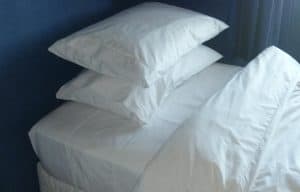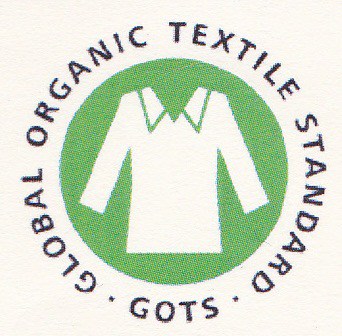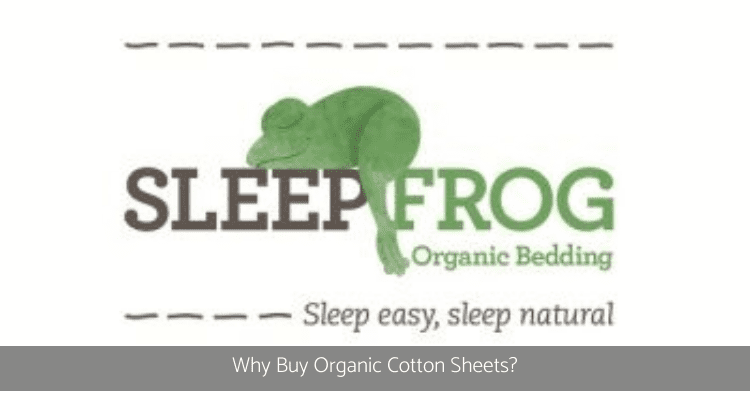We asked our supplier of SleepFROG organic cotton sheets to tell us more about their products and why we should be buying materials made from organic cotton. This is a new product for us here at Mitey Fresh from our long time colleagues from across the ditch in New Zealand. As you know, we don’t just offer any old product, we like to ensure we have researched and tested to offer you something we have complete confidence in.
SleepFROG has a beautiful range of certified organic cotton sheets that are made in New Zealand to a high quality standard. White, classic and guaranteed to be better for your health and for our planet!
Why buy organic cotton?
Did you know it takes about 500 grams of pesticides and synthetic fertilizers to grow the cotton needed to make just one sheet! Not only is this harmful for the environment, but the residues of these toxins can remain in the end product for a very long time. Organic bed linen is free from the toxic dyes and insecticides used in conventional cotton production.
Over our lifetime, we will spend about 250,000 hours in bed – and that means a lot of contact time with bedding that contain harmful chemicals. While you are sleeping, the toxins from chemicals found in bedding materials can be breathed in and absorbed through your skin into your body. Our bodies are already constantly fighting the toxins found in the products and environment around us. By using organic cotton sheets, you help create an environment in your home that allows your body’s defence systems a chance to recuperate and rejuvenate.
- Good for you and your family, as well as environmentally friendly
- Hypoallergenic & safe
- Durable and long lasting – organic fibres grow stronger. When cared for properly, organic cotton linens last longer than conventional products
- Certified organic by SKAL International which means you are guaranteed that this product is 100% organic cotton
PRODUCT:
SleepFROG Organic Cotton Sheet Sets
Our organic white cotton sheets are breathable and cool with a nice crisp feel, making it an ideal fabric for a good night’s sleep and at the same time providing you with an eloquent look for any bedroom.

Ever questioned why buying organic cotton sheets is justifiable? The below comparison will hopefully give you some comfort for thought (pun intended!) as you consider your next purchase of sheets – for yourself and your family. An organic certification will normally cover every aspect of the growing, harvesting, cleaning, dyeing, printing and finishing processes which go into making your organic sheets.
Cotton | Certified Organic Cotton |
| Planting – cotton is grown using GM seeds to ensure higher yield. | Soil – cotton fields need to be pesticide and fertiliser free for a period of 3 years before they can be certified organic. No GM seeds– untreated seeds welcome beneficial insects and companion planting is introduced and the crops are manually tilled. |
Growing – cotton is very prone to disease and pests like aphids, lygus bug, thrips, army worm, cut worm, spider mite, boll weevil, spider mite. Pesticides are also used to produce a higher yield – in fact cotton is one of the most heavily laden crops (with poisons). This is harmful to workers and the environment. | Growing – no fertilisers, pesticides or chemicals are used. The soil is manually tilled and companion planting is introduced to eradicate pests and diseases |
| Harvesting – toxic chemicals are used to induce the crop | Harvesting – organic cotton is hand-picked using natural defoliation methods either by freezing temperatures or water management. This method works in harmony with the natural environment. |
| Scouring and bleaching – chlorine, hydrogen peroxide and APEO (alkylphenoloxylate EDTA (ethylenediamine tetra-acetate; VOCs Volatileorganic compounds are used to clean the cotton | Whitening– safe bleaches are used and low impact/azo free dyes or natural dyes are used for dyeing the fabrics. Washing– organic cotton requires less water than conventional cotton due to the fact that it does not have the intense load of chemicals applied throughout the growing and manufacturing phase. The water is able to be recycled which helps to preserve waterways. |
Cleaning and yarn dyeing – far more water is required to wash away the chemicals – this leaches into water ways affecting soils and people in the environment | Yarn Dyeing –Azo free, low impact dyes or natural dyes are used to dye the yarn or fabric. All dyes are certified for use GOTS Global Organic Textile Standards. |
Printing – Conventional cotton uses inks which are solvent based containing heavy metals, benzene, and organochlorides. | Printing – Mineral inks or low impact dues are used which are certified by an independent third party such as GOTS Global Organic Textile Standards. |
Finishing – Many different finishes and therefore chemicals are applied to conventional fabrics to make them either stain resistant, fire resistant, wrinkle free, deodorizing, soft hand. A range of chemicals may be used including Formaldehyde a fire retardant, sulfuric acid, bromines, urea resins for stain resistance, sulfonamides, halogens, and bromines. | Finishing– organic cotton fabric is left natural. There are no processes or finishes used on the organic cotton. |
| Price cheaper than organic, it’s true! But the environmental and social impacts are huge. | Price– Better for the planet – the higher price is justified when we think of future generations and the ‘ethics’ Shop for organic cotton sheets! |
100% Certified Organic Cotton, no chemical bleach- White
- Free from pesticides, brighteners, formaldehyde and other harmful chemicals that can irritate and be absorbed through your skin – making it a safer, more comfortable sleep for you and your family.
- Finest quality, durable organic cotton.
- Thread count 250psqcm (300p10cm NZ measure) with thicker than usual superior length yarn.
- Machine washable using eco-friendly laundry powder.
 This is great information that shows us the benefits of buying organic cotton. Yes, they are a little more expensive but I think we can all agree, the benefits to ourselves, our family and our planet make it worthwhile.
This is great information that shows us the benefits of buying organic cotton. Yes, they are a little more expensive but I think we can all agree, the benefits to ourselves, our family and our planet make it worthwhile.
As Principal Consultant to Mitey Fresh since 1996, I have acquired knowledge of adverse health effects at the client’s properties and recommend effective strategies to reduce occupants’ exposure by eliminating and controlling as many sources of pollutants in order to create healthy indoor living environments that are as exposure-free and natural as practically possible.
Towards healthier living, Carol Parr ♥
References:
Made in New Zealand by SleepFROG using Organic Cotton certified under the Global Organic Textile Standard (GOTS): Certified by Control Union Certifications BV, Meeuwenlaan4-6, Zwolle, Netherlands. Certified Fair Trade by FLO-Cert, Bonn, Germany.
Author
-
We’re glad you’re here. We’re Carol and Tony, founders of one of the longest running Healthy Home Blogs in the world, Mitey Fresh Australia. We’ve been on this journey for the last 25 years and are passionate about helping families sift through health hazards and triggers like allergens, mould, water damage, chemicals and EMFs, to get clarity about what’s toxic and what’s not so they can create a healthy and happy home for their family they love. Each month, people visit this blog seeking focus on the health and wellbeing of their loved ones, sustainable and effective practice tips and guides, to help create and manage healthier indoor spaces, improve the built environment that is pleasing to the senses and support healthy living and nature, every day. Starting this blog was to help change people’s lives, one family at a time, and we can’t wait to share how its allowed us to stand next to you and show you how interpreting these synergies between buildings and the environment they are built in will impact upon the health and well-being of those who occupy them. Find out more about Healthy Homes and what this blog can do for you!





